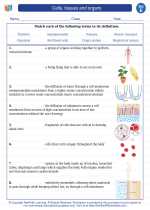Cells, tissues and organs -> minerals
Minerals
Minerals are naturally occurring, inorganic substances that have a specific chemical composition and a crystalline structure. They are the building blocks of rocks and are essential for the functioning of the Earth's crust. Understanding minerals is important for various scientific fields, including geology, chemistry, and environmental science.
Properties of Minerals
Minerals have several defining properties that can be used to identify and classify them:
- Color: The visible color of a mineral can provide clues about its composition, but it's not always a reliable indicator.
- Luster: This refers to the way light reflects off the surface of a mineral. Common types of luster include metallic, vitreous (glassy), and dull.
- Hardness: The Mohs scale is used to measure the hardness of minerals, ranging from 1 (softest, like talc) to 10 (hardest, like diamond).
- Streak: The color of a mineral's powdered form, which can differ from its visible color.
- Crystal Structure: Minerals form distinct crystal shapes based on their internal atomic arrangement.
- Cleavage and Fracture: These describe how a mineral breaks when subjected to stress.
- Specific Gravity: The density of a mineral compared to the density of water.
Formation of Minerals
Minerals can form through various processes, including:
- Crystallization from Magma: When molten rock cools and solidifies, minerals crystallize from the cooling magma.
- Evaporation: When a body of water evaporates, dissolved minerals are left behind and form crystals.
- Pressure and Temperature Changes: Minerals can recrystallize under high pressure and temperature conditions deep within the Earth's crust.
- Biological Processes: Some minerals form as a result of biological activity, such as the formation of shells and skeletons made of calcium carbonate.
Uses of Minerals
Minerals have a wide range of practical uses in everyday life and industry:
- Metals such as iron, copper, and aluminum are extracted from minerals and used in construction, manufacturing, and technology.
- Gems and precious stones, such as diamonds and rubies, are prized for their beauty and used in jewelry and decorative items.
- Minerals like quartz and feldspar are used in the production of glass, ceramics, and electronics.
- Minerals are also important in agriculture, as they provide essential nutrients for plant growth in the form of fertilizers.
Study Guide
To study minerals effectively, consider the following tips:
- Learn to identify common minerals based on their physical properties, such as color, luster, hardness, and cleavage.
- Understand the formation processes of minerals and the conditions under which they are likely to occur.
- Explore the practical applications of minerals in various industries and their significance in the global economy.
- Practice using tools like the Mohs scale and streak testing to determine the properties of unknown minerals.
- Engage in hands-on activities, such as mineral identification kits and field trips to mineral-rich areas, to gain practical experience.
By mastering the properties, formation, and uses of minerals, you'll develop a deeper appreciation for the natural world and its geological treasures.
[Minerals] Related Worksheets and Study Guides:
.◂Science Worksheets and Study Guides Fifth Grade. Cells, tissues and organs

 Worksheet/Answer key
Worksheet/Answer key
 Worksheet/Answer key
Worksheet/Answer key
 Worksheet/Answer key
Worksheet/Answer key
 Vocabulary/Answer key
Vocabulary/Answer key
 Vocabulary/Answer key
Vocabulary/Answer key
 Vocabulary/Answer key
Vocabulary/Answer key
 Vocabulary/Answer key
Vocabulary/Answer key
 Vocabulary/Answer key
Vocabulary/Answer key
 Vocabulary/Answer key
Vocabulary/Answer key
